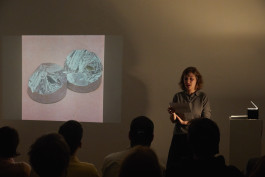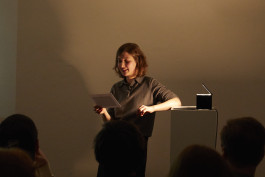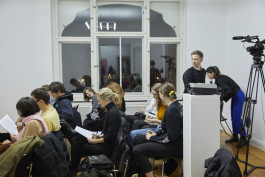

Olga Hohmann
The Overview Effect

The Overview Effect
Nuclear Fission
At an approximate distance of 18,000 miles from earth’s surface, the crew of Apollo 17 takes the first picture of the planet as a whole. In doing so, modernity’s promise is fulfilled as it is simultaneously revealed in its constitutive impossibility. The event sublates enlightenment’s project of elevating man above nature through the means of the scientific-rationalistic method — by escaping the entanglement and constraints of the immediate with the aid of abstraction. Division is paradigmatic for such a configuration, which is essentially one of analysis, seeking to take an object apart, and, as the sober view of the scientist implies, also distances itself from the object, no matter if it deals with the planetary macrolevel or the smallest subatomic particles. In view of the earth as a whole, the dimension of above-ness (the bodiless god-view) concurrently interlocks with the with-ness (the always already being-involved-in-things). That there is no outside is the insight that flashes through. Not least is the fact that the ‘blue marble’ called photography turned into an icon of the environmentalist movement, an expression of its capability to epitomise the fragile connectivity of the overall context and our vulnerable entanglement with what surrounds us.
It is indeed a tragic dimension of consciousness, which necessarily relates to the world in a judgemental manner, that these exact judgments [Urteile] are always also a repetition of the original/archetypical division [Ur-teilung] between subject and object, even if the subject is itself part of the world — not to speak of the violence always already present in the judgement as condemnation [Ver-urteilung]. The constellation of modernity is, after all, marked by a domination of nature — the external as much as the internal.
Though, what always sneaks its way into these relations, is an unacknowledged excess of pleasure. Whether it is the scientific or the bourgeois safari: the subject hunts for objects, which it fits into either its taxonomical system or archives in its domestic slide collection. The smart TED-talker gets excited about every new problem supposedly solvable by technology, like the frantic cleaner when they encounter dirt. As with nuclear fission, the fission between subject and object releases a surplus of energy, that drives out, drives on and keeps disturbing. With it comes the threat of the maximal credible accident [MCA] of the core meltdown, that in a way also is longed for.
The flipside of the neurotic forward-storming is the yearning for a primordial undividedness — which ultimately is nothing but a retroactive phantasm of immediacy, that imagines a utopian state allegedly lost by the split. This image is active in the context of love, politics and not least art.
In the latter it is expressed in the discontent regarding representation, which uses images, signs and symbols, themselves always also abstractions in their basic functioning. As they subsume the particular-atomic under universals, they time and again exercise a force upon things (the violence of symbolic subjugation). What in return is called for is to mobilise an ostensible immediacy of affects, an immersion that supposed to dissolves the boundary between work and recipient, or a procedural incompleteness of art making. The gap shall be exorcised.
But what if the maximal credible accident, the uncontrolled nuclear fission and chain reaction, already happened? Instead of seeking to stuff up the negativity of the split, we should, on the contrary, totalise it. The rupture does not appear first between me and the object, but it is already active as the split in the object. The Above-ness is already at work, in a peculiar way, in the scission of the object in regard to itself. We should invert the notion, that we can never grasp the things in their essence, in their in-itself, because we are only perceiving appearances, which are precisely not their essence (respectively: we use notions/images/narratives, that subjugate objects, already because they are not the object themselves) — but it is rather the break, the gap between the essence of a thing and its appearance, that belongs to the object as such. This is akin to the mask that masks the fact that there is nothing to mask. Things appear — even though there is nothing behind the appearances, those appearances nevertheless produce a ‘virtual essence’, which as an illusion, has a reality. It is therefore crucial that we are not dealing here with ‘mere’ appearances only. The gap between the different levels is not reducible, which means that there ‘are’ breaks in the sense of a productive-dynamic negativity. Things are in a fundamental way not identical with themselves.
This dynamic is similar to the paradoxical topology of the Möbius strip, which has the odd characteristic, that if one walks on it, one finds oneself on the opposite side of the initial starting point. Even if every specific point has an other side, the strip only consists of one surface. We are dealing here with an immanent transcendence, in which a single surface becomes alien to itself although there is only it.
Let's follow the objects, which through their break, become what they are not and therefore step into a chain of relations with others! A psychoanalysis of things is necessary: A free association of objects, that makes things speak and thereby loosens the knot of their reification.
- Florian Endres




Olga Hohmann
The Overview Effect

The Overview Effect
Nuclear Fission
At an approximate distance of 18,000 miles from earth’s surface, the crew of Apollo 17 takes the first picture of the planet as a whole. In doing so, modernity’s promise is fulfilled as it is simultaneously revealed in its constitutive impossibility. The event sublates enlightenment’s project of elevating man above nature through the means of the scientific-rationalistic method — by escaping the entanglement and constraints of the immediate with the aid of abstraction. Division is paradigmatic for such a configuration, which is essentially one of analysis, seeking to take an object apart, and, as the sober view of the scientist implies, also distances itself from the object, no matter if it deals with the planetary macrolevel or the smallest subatomic particles. In view of the earth as a whole, the dimension of above-ness (the bodiless god-view) concurrently interlocks with the with-ness (the always already being-involved-in-things). That there is no outside is the insight that flashes through. Not least is the fact that the ‘blue marble’ called photography turned into an icon of the environmentalist movement, an expression of its capability to epitomise the fragile connectivity of the overall context and our vulnerable entanglement with what surrounds us.
It is indeed a tragic dimension of consciousness, which necessarily relates to the world in a judgemental manner, that these exact judgments [Urteile] are always also a repetition of the original/archetypical division [Ur-teilung] between subject and object, even if the subject is itself part of the world — not to speak of the violence always already present in the judgement as condemnation [Ver-urteilung]. The constellation of modernity is, after all, marked by a domination of nature — the external as much as the internal.
Though, what always sneaks its way into these relations, is an unacknowledged excess of pleasure. Whether it is the scientific or the bourgeois safari: the subject hunts for objects, which it fits into either its taxonomical system or archives in its domestic slide collection. The smart TED-talker gets excited about every new problem supposedly solvable by technology, like the frantic cleaner when they encounter dirt. As with nuclear fission, the fission between subject and object releases a surplus of energy, that drives out, drives on and keeps disturbing. With it comes the threat of the maximal credible accident [MCA] of the core meltdown, that in a way also is longed for.
The flipside of the neurotic forward-storming is the yearning for a primordial undividedness — which ultimately is nothing but a retroactive phantasm of immediacy, that imagines a utopian state allegedly lost by the split. This image is active in the context of love, politics and not least art.
In the latter it is expressed in the discontent regarding representation, which uses images, signs and symbols, themselves always also abstractions in their basic functioning. As they subsume the particular-atomic under universals, they time and again exercise a force upon things (the violence of symbolic subjugation). What in return is called for is to mobilise an ostensible immediacy of affects, an immersion that supposed to dissolves the boundary between work and recipient, or a procedural incompleteness of art making. The gap shall be exorcised.
But what if the maximal credible accident, the uncontrolled nuclear fission and chain reaction, already happened? Instead of seeking to stuff up the negativity of the split, we should, on the contrary, totalise it. The rupture does not appear first between me and the object, but it is already active as the split in the object. The Above-ness is already at work, in a peculiar way, in the scission of the object in regard to itself. We should invert the notion, that we can never grasp the things in their essence, in their in-itself, because we are only perceiving appearances, which are precisely not their essence (respectively: we use notions/images/narratives, that subjugate objects, already because they are not the object themselves) — but it is rather the break, the gap between the essence of a thing and its appearance, that belongs to the object as such. This is akin to the mask that masks the fact that there is nothing to mask. Things appear — even though there is nothing behind the appearances, those appearances nevertheless produce a ‘virtual essence’, which as an illusion, has a reality. It is therefore crucial that we are not dealing here with ‘mere’ appearances only. The gap between the different levels is not reducible, which means that there ‘are’ breaks in the sense of a productive-dynamic negativity. Things are in a fundamental way not identical with themselves.
This dynamic is similar to the paradoxical topology of the Möbius strip, which has the odd characteristic, that if one walks on it, one finds oneself on the opposite side of the initial starting point. Even if every specific point has an other side, the strip only consists of one surface. We are dealing here with an immanent transcendence, in which a single surface becomes alien to itself although there is only it.
Let's follow the objects, which through their break, become what they are not and therefore step into a chain of relations with others! A psychoanalysis of things is necessary: A free association of objects, that makes things speak and thereby loosens the knot of their reification.
- Florian Endres





Anton Janizewski Galerie,